CMI Level 7 Marketing Strategy Report: Coca-Cola Company Analysis
VerifiedAdded on 2021/11/23
|23
|5725
|101
Report
AI Summary
This report provides a comprehensive analysis of The Coca-Cola Company's (Coca-Cola Beverages Sri Lanka Limited) marketing strategy. It examines the company's approaches to attract and retain customers, incorporating frameworks like PESTEL, SWOT, Porter's Value Chain, and Porter's Five Forces to evaluate internal and external factors influencing the marketing strategy. The report also explores the influence of the company's strategic aims, evolving market environments, and digital marketing trends on its marketing strategy. Furthermore, it reviews the company's strategic goals and objectives, marketing frameworks, and the impact of changing market environments. This report is a valuable resource for understanding Coca-Cola's marketing strategies in the context of its business operations, strategic objectives, and market dynamics.

Marketing Strategy
Marketing Strategy
CMI-APR-2021-LV7-84
Marketing Strategy CMI-APR-2021-LV7-84
1
Marketing Strategy
CMI-APR-2021-LV7-84
Marketing Strategy CMI-APR-2021-LV7-84
1
Paraphrase This Document
Need a fresh take? Get an instant paraphrase of this document with our AI Paraphraser

Marketing Strategy CMI-APR-2021-LV7-84
Learner Statement of Authenticity
This statement must be completed and signed by the learner and accompany the
assignment.
Learner Name: P R W M D N Weerakotuwa
Learner Number: CMI-APR-2021-LV7-84
Centre: Cambridge College
Qualification: CMI Level 7
Unit Title and Number: Marketing Strategy – CMI710
Learner Statement of Authenticity:
I confirm that the attached completed assignment is all my own work, and does
not include any work completed by anyone other than myself. I have completed
the assignment in accordance with CMI’s instructions and within the time limits set
by my Centre. By signing my name below, I am agreeing that I have read and
understood the Learner Statement of Authenticity.
Signature:
Date: 14.08.2021
Centre Confirmation of Authenticity:
I confirm that this learner:
is registered at this CMI Centre on a programme of study leading to a
Chartered Management Institute qualification.
is, to the best of my knowledge, the sole author of the completed
assessment submitted and has been completed in accordance with CMI
instructions and within the time limits set. I have had the opportunity to
monitor and question the learner during the completion of this assessment.
Name and job title:
Signature:
2
Learner Statement of Authenticity
This statement must be completed and signed by the learner and accompany the
assignment.
Learner Name: P R W M D N Weerakotuwa
Learner Number: CMI-APR-2021-LV7-84
Centre: Cambridge College
Qualification: CMI Level 7
Unit Title and Number: Marketing Strategy – CMI710
Learner Statement of Authenticity:
I confirm that the attached completed assignment is all my own work, and does
not include any work completed by anyone other than myself. I have completed
the assignment in accordance with CMI’s instructions and within the time limits set
by my Centre. By signing my name below, I am agreeing that I have read and
understood the Learner Statement of Authenticity.
Signature:
Date: 14.08.2021
Centre Confirmation of Authenticity:
I confirm that this learner:
is registered at this CMI Centre on a programme of study leading to a
Chartered Management Institute qualification.
is, to the best of my knowledge, the sole author of the completed
assessment submitted and has been completed in accordance with CMI
instructions and within the time limits set. I have had the opportunity to
monitor and question the learner during the completion of this assessment.
Name and job title:
Signature:
2

Marketing Strategy CMI-APR-2021-LV7-84
Table of Contents
No table of contents entries found.
3
Table of Contents
No table of contents entries found.
3
⊘ This is a preview!⊘
Do you want full access?
Subscribe today to unlock all pages.

Trusted by 1+ million students worldwide

Marketing Strategy CMI-APR-2021-LV7-84
Acknowledgement
Mr. Chathura Ganegoda, our marketing strategy module instructor, has been a wonderful assistance
to me throughout the course. His encouragement, marketing experience, and material provided in
lectures were really helpful in attaining a higher module outcome.
Also I would like thank Cambridge College for doing a great service and providing the students with
necessary assistance whenever needed.
4
Acknowledgement
Mr. Chathura Ganegoda, our marketing strategy module instructor, has been a wonderful assistance
to me throughout the course. His encouragement, marketing experience, and material provided in
lectures were really helpful in attaining a higher module outcome.
Also I would like thank Cambridge College for doing a great service and providing the students with
necessary assistance whenever needed.
4
Paraphrase This Document
Need a fresh take? Get an instant paraphrase of this document with our AI Paraphraser
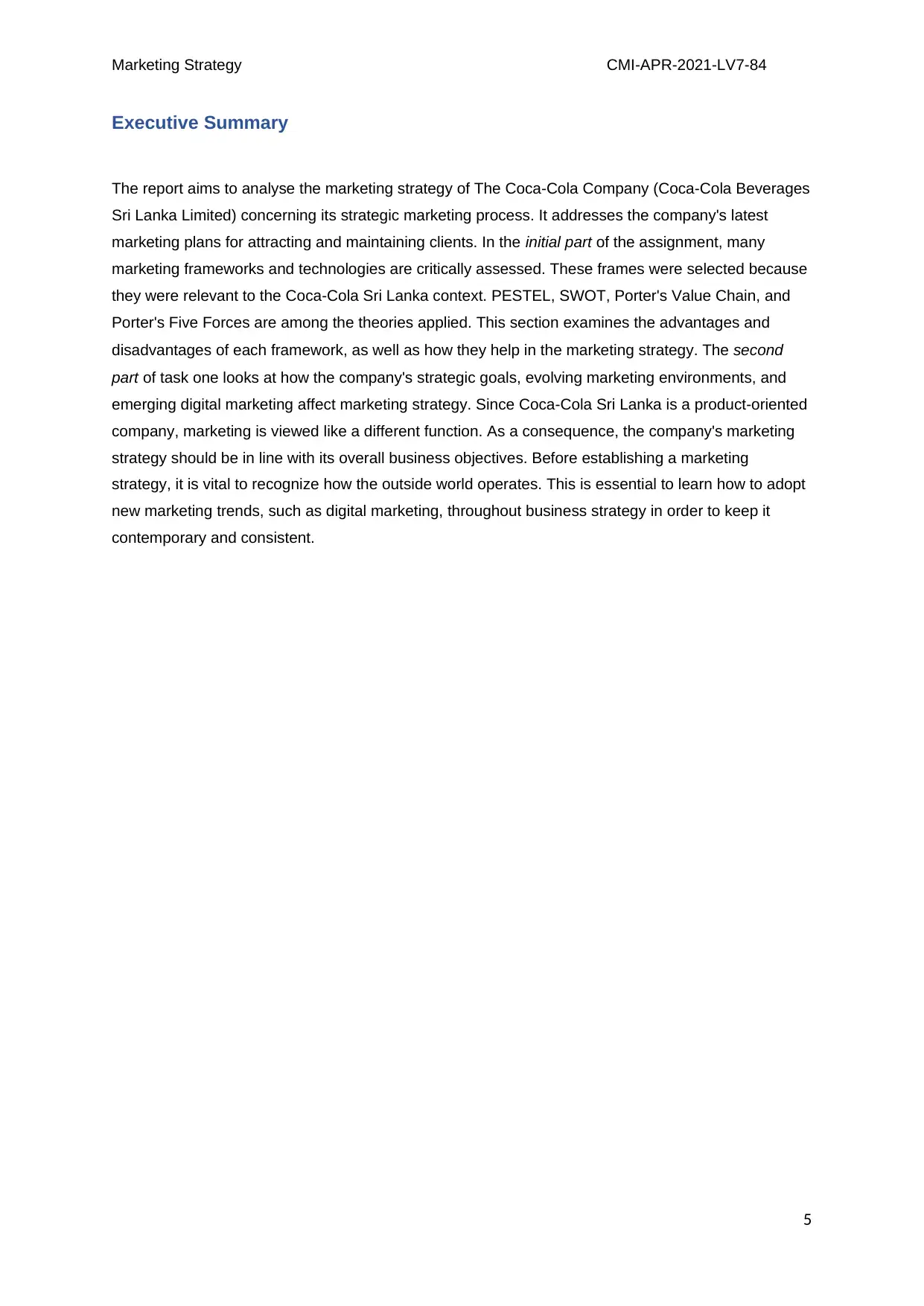
Marketing Strategy CMI-APR-2021-LV7-84
Executive Summary
The report aims to analyse the marketing strategy of The Coca-Cola Company (Coca-Cola Beverages
Sri Lanka Limited) concerning its strategic marketing process. It addresses the company's latest
marketing plans for attracting and maintaining clients. In the initial part of the assignment, many
marketing frameworks and technologies are critically assessed. These frames were selected because
they were relevant to the Coca-Cola Sri Lanka context. PESTEL, SWOT, Porter's Value Chain, and
Porter's Five Forces are among the theories applied. This section examines the advantages and
disadvantages of each framework, as well as how they help in the marketing strategy. The second
part of task one looks at how the company's strategic goals, evolving marketing environments, and
emerging digital marketing affect marketing strategy. Since Coca-Cola Sri Lanka is a product-oriented
company, marketing is viewed like a different function. As a consequence, the company's marketing
strategy should be in line with its overall business objectives. Before establishing a marketing
strategy, it is vital to recognize how the outside world operates. This is essential to learn how to adopt
new marketing trends, such as digital marketing, throughout business strategy in order to keep it
contemporary and consistent.
5
Executive Summary
The report aims to analyse the marketing strategy of The Coca-Cola Company (Coca-Cola Beverages
Sri Lanka Limited) concerning its strategic marketing process. It addresses the company's latest
marketing plans for attracting and maintaining clients. In the initial part of the assignment, many
marketing frameworks and technologies are critically assessed. These frames were selected because
they were relevant to the Coca-Cola Sri Lanka context. PESTEL, SWOT, Porter's Value Chain, and
Porter's Five Forces are among the theories applied. This section examines the advantages and
disadvantages of each framework, as well as how they help in the marketing strategy. The second
part of task one looks at how the company's strategic goals, evolving marketing environments, and
emerging digital marketing affect marketing strategy. Since Coca-Cola Sri Lanka is a product-oriented
company, marketing is viewed like a different function. As a consequence, the company's marketing
strategy should be in line with its overall business objectives. Before establishing a marketing
strategy, it is vital to recognize how the outside world operates. This is essential to learn how to adopt
new marketing trends, such as digital marketing, throughout business strategy in order to keep it
contemporary and consistent.
5
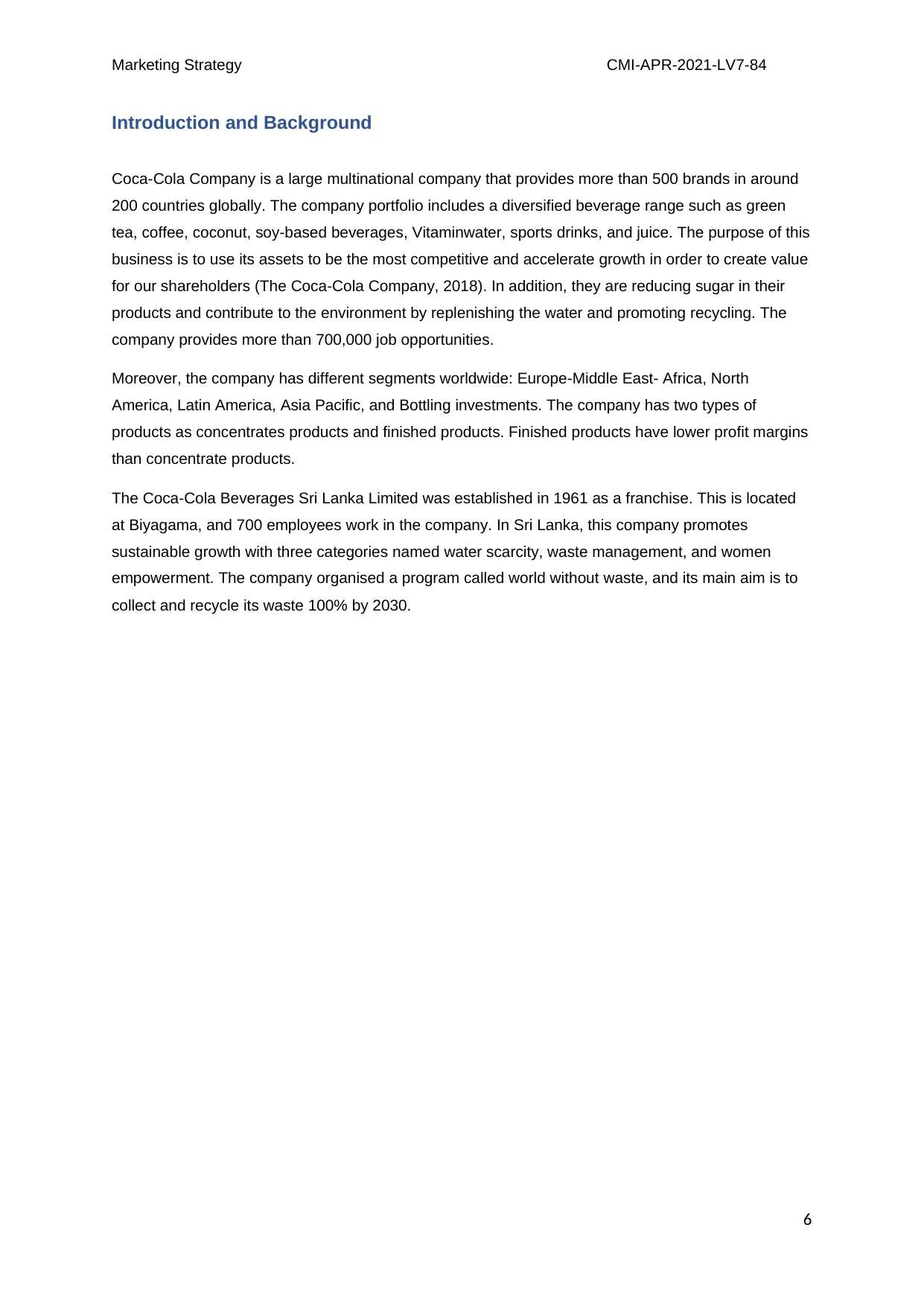
Marketing Strategy CMI-APR-2021-LV7-84
Introduction and Background
Coca-Cola Company is a large multinational company that provides more than 500 brands in around
200 countries globally. The company portfolio includes a diversified beverage range such as green
tea, coffee, coconut, soy-based beverages, Vitaminwater, sports drinks, and juice. The purpose of this
business is to use its assets to be the most competitive and accelerate growth in order to create value
for our shareholders (The Coca-Cola Company, 2018). In addition, they are reducing sugar in their
products and contribute to the environment by replenishing the water and promoting recycling. The
company provides more than 700,000 job opportunities.
Moreover, the company has different segments worldwide: Europe-Middle East- Africa, North
America, Latin America, Asia Pacific, and Bottling investments. The company has two types of
products as concentrates products and finished products. Finished products have lower profit margins
than concentrate products.
The Coca-Cola Beverages Sri Lanka Limited was established in 1961 as a franchise. This is located
at Biyagama, and 700 employees work in the company. In Sri Lanka, this company promotes
sustainable growth with three categories named water scarcity, waste management, and women
empowerment. The company organised a program called world without waste, and its main aim is to
collect and recycle its waste 100% by 2030.
6
Introduction and Background
Coca-Cola Company is a large multinational company that provides more than 500 brands in around
200 countries globally. The company portfolio includes a diversified beverage range such as green
tea, coffee, coconut, soy-based beverages, Vitaminwater, sports drinks, and juice. The purpose of this
business is to use its assets to be the most competitive and accelerate growth in order to create value
for our shareholders (The Coca-Cola Company, 2018). In addition, they are reducing sugar in their
products and contribute to the environment by replenishing the water and promoting recycling. The
company provides more than 700,000 job opportunities.
Moreover, the company has different segments worldwide: Europe-Middle East- Africa, North
America, Latin America, Asia Pacific, and Bottling investments. The company has two types of
products as concentrates products and finished products. Finished products have lower profit margins
than concentrate products.
The Coca-Cola Beverages Sri Lanka Limited was established in 1961 as a franchise. This is located
at Biyagama, and 700 employees work in the company. In Sri Lanka, this company promotes
sustainable growth with three categories named water scarcity, waste management, and women
empowerment. The company organised a program called world without waste, and its main aim is to
collect and recycle its waste 100% by 2030.
6
⊘ This is a preview!⊘
Do you want full access?
Subscribe today to unlock all pages.

Trusted by 1+ million students worldwide
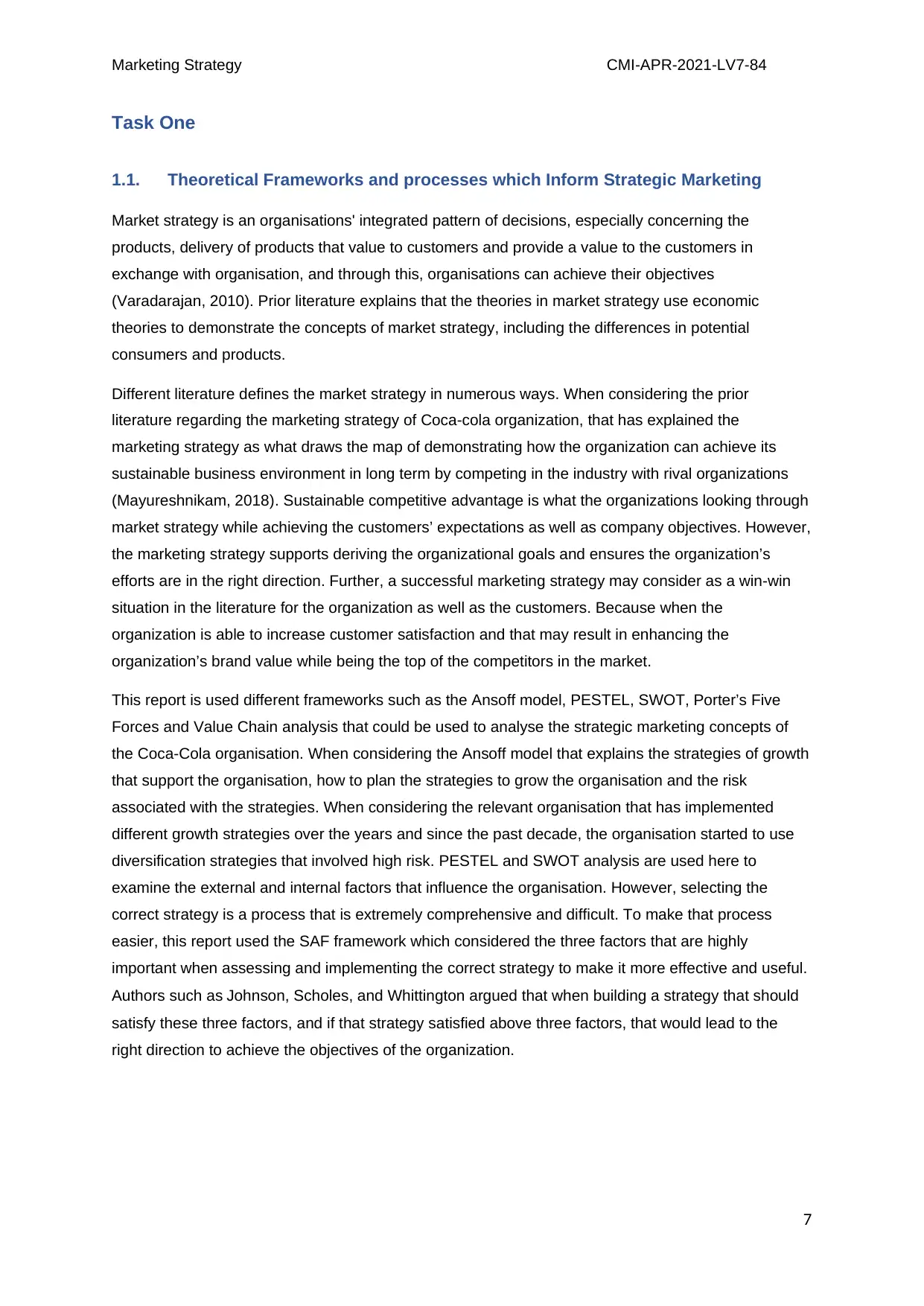
Marketing Strategy CMI-APR-2021-LV7-84
Task One
1.1. Theoretical Frameworks and processes which Inform Strategic Marketing
Market strategy is an organisations' integrated pattern of decisions, especially concerning the
products, delivery of products that value to customers and provide a value to the customers in
exchange with organisation, and through this, organisations can achieve their objectives
(Varadarajan, 2010). Prior literature explains that the theories in market strategy use economic
theories to demonstrate the concepts of market strategy, including the differences in potential
consumers and products.
Different literature defines the market strategy in numerous ways. When considering the prior
literature regarding the marketing strategy of Coca-cola organization, that has explained the
marketing strategy as what draws the map of demonstrating how the organization can achieve its
sustainable business environment in long term by competing in the industry with rival organizations
(Mayureshnikam, 2018). Sustainable competitive advantage is what the organizations looking through
market strategy while achieving the customers’ expectations as well as company objectives. However,
the marketing strategy supports deriving the organizational goals and ensures the organization’s
efforts are in the right direction. Further, a successful marketing strategy may consider as a win-win
situation in the literature for the organization as well as the customers. Because when the
organization is able to increase customer satisfaction and that may result in enhancing the
organization’s brand value while being the top of the competitors in the market.
This report is used different frameworks such as the Ansoff model, PESTEL, SWOT, Porter’s Five
Forces and Value Chain analysis that could be used to analyse the strategic marketing concepts of
the Coca-Cola organisation. When considering the Ansoff model that explains the strategies of growth
that support the organisation, how to plan the strategies to grow the organisation and the risk
associated with the strategies. When considering the relevant organisation that has implemented
different growth strategies over the years and since the past decade, the organisation started to use
diversification strategies that involved high risk. PESTEL and SWOT analysis are used here to
examine the external and internal factors that influence the organisation. However, selecting the
correct strategy is a process that is extremely comprehensive and difficult. To make that process
easier, this report used the SAF framework which considered the three factors that are highly
important when assessing and implementing the correct strategy to make it more effective and useful.
Authors such as Johnson, Scholes, and Whittington argued that when building a strategy that should
satisfy these three factors, and if that strategy satisfied above three factors, that would lead to the
right direction to achieve the objectives of the organization.
7
Task One
1.1. Theoretical Frameworks and processes which Inform Strategic Marketing
Market strategy is an organisations' integrated pattern of decisions, especially concerning the
products, delivery of products that value to customers and provide a value to the customers in
exchange with organisation, and through this, organisations can achieve their objectives
(Varadarajan, 2010). Prior literature explains that the theories in market strategy use economic
theories to demonstrate the concepts of market strategy, including the differences in potential
consumers and products.
Different literature defines the market strategy in numerous ways. When considering the prior
literature regarding the marketing strategy of Coca-cola organization, that has explained the
marketing strategy as what draws the map of demonstrating how the organization can achieve its
sustainable business environment in long term by competing in the industry with rival organizations
(Mayureshnikam, 2018). Sustainable competitive advantage is what the organizations looking through
market strategy while achieving the customers’ expectations as well as company objectives. However,
the marketing strategy supports deriving the organizational goals and ensures the organization’s
efforts are in the right direction. Further, a successful marketing strategy may consider as a win-win
situation in the literature for the organization as well as the customers. Because when the
organization is able to increase customer satisfaction and that may result in enhancing the
organization’s brand value while being the top of the competitors in the market.
This report is used different frameworks such as the Ansoff model, PESTEL, SWOT, Porter’s Five
Forces and Value Chain analysis that could be used to analyse the strategic marketing concepts of
the Coca-Cola organisation. When considering the Ansoff model that explains the strategies of growth
that support the organisation, how to plan the strategies to grow the organisation and the risk
associated with the strategies. When considering the relevant organisation that has implemented
different growth strategies over the years and since the past decade, the organisation started to use
diversification strategies that involved high risk. PESTEL and SWOT analysis are used here to
examine the external and internal factors that influence the organisation. However, selecting the
correct strategy is a process that is extremely comprehensive and difficult. To make that process
easier, this report used the SAF framework which considered the three factors that are highly
important when assessing and implementing the correct strategy to make it more effective and useful.
Authors such as Johnson, Scholes, and Whittington argued that when building a strategy that should
satisfy these three factors, and if that strategy satisfied above three factors, that would lead to the
right direction to achieve the objectives of the organization.
7
Paraphrase This Document
Need a fresh take? Get an instant paraphrase of this document with our AI Paraphraser

Marketing Strategy CMI-APR-2021-LV7-84
1.2. Discuss the influence of an Organisation's strategic aims and context on a
marketing strategy
The company’s vision is to create a “Loved Brands, Sustainability and Better shared future” (The
Coca-Cola Company, 2021). Company objectives are, refresh the world and make a difference,
passion for people and their lives, cutting edge excellence in ingredient, design, marketing, and
innovation, grow business while reducing sugar, packaging with 100% collection, and reuse without
waste, invest in employee’s personal growth and talents.
When considering the organisation's strategic aims, which focus on market segmentation, brand
establishments and customer relationship, increasing financial and process efficiency, significant
consideration on core competencies and business model, when considering the market segmentation,
Coca-Cola has divided its market based on the capacity and the volume such as developed,
emerging, and developing markets. In developing markets such as Sri Lanka, they have considered
increasing sales rather than focusing on profits. Through that, the organisation believed that it would
achieve customer loyalty as well as the domain. Such simple and strategical methods were used
considering the context to achieve the current position in the domestic market and the world.
Coca-Cola made the wise decision to invest more than $250 million in updating and refining their
advertisements in order to increase the product's value. These commercials are targeted at creating a
perception of audiences by integrating Coca-Cola from a once-in-a-while beverage into a key
component of people's lives. During the same time, significant alliances were made with Monster
Beverage Corporation, Suja (a premium organic juice brand), Fairlife ultra filtered milk, and others to
strengthen their strategic performance in the energy drink, juice, and healthy drink sectors.
The relevant questions the steps of marketing strategy are mentioned in the following table.
Key Questions Relevant Step in Marketing Plan
Where are we now and how did we get here? SWOT Analysis
Marketing Audit
Where are we going? Marketing Audit
5C Analysis
Where would we like to be? Mission Statement
SMARY Objectives
How can we get there? Define target audience
Set measurable goals
Create a budget
Table 01: Strategic Aims and Relevance to Marketing Strategy
8
1.2. Discuss the influence of an Organisation's strategic aims and context on a
marketing strategy
The company’s vision is to create a “Loved Brands, Sustainability and Better shared future” (The
Coca-Cola Company, 2021). Company objectives are, refresh the world and make a difference,
passion for people and their lives, cutting edge excellence in ingredient, design, marketing, and
innovation, grow business while reducing sugar, packaging with 100% collection, and reuse without
waste, invest in employee’s personal growth and talents.
When considering the organisation's strategic aims, which focus on market segmentation, brand
establishments and customer relationship, increasing financial and process efficiency, significant
consideration on core competencies and business model, when considering the market segmentation,
Coca-Cola has divided its market based on the capacity and the volume such as developed,
emerging, and developing markets. In developing markets such as Sri Lanka, they have considered
increasing sales rather than focusing on profits. Through that, the organisation believed that it would
achieve customer loyalty as well as the domain. Such simple and strategical methods were used
considering the context to achieve the current position in the domestic market and the world.
Coca-Cola made the wise decision to invest more than $250 million in updating and refining their
advertisements in order to increase the product's value. These commercials are targeted at creating a
perception of audiences by integrating Coca-Cola from a once-in-a-while beverage into a key
component of people's lives. During the same time, significant alliances were made with Monster
Beverage Corporation, Suja (a premium organic juice brand), Fairlife ultra filtered milk, and others to
strengthen their strategic performance in the energy drink, juice, and healthy drink sectors.
The relevant questions the steps of marketing strategy are mentioned in the following table.
Key Questions Relevant Step in Marketing Plan
Where are we now and how did we get here? SWOT Analysis
Marketing Audit
Where are we going? Marketing Audit
5C Analysis
Where would we like to be? Mission Statement
SMARY Objectives
How can we get there? Define target audience
Set measurable goals
Create a budget
Table 01: Strategic Aims and Relevance to Marketing Strategy
8
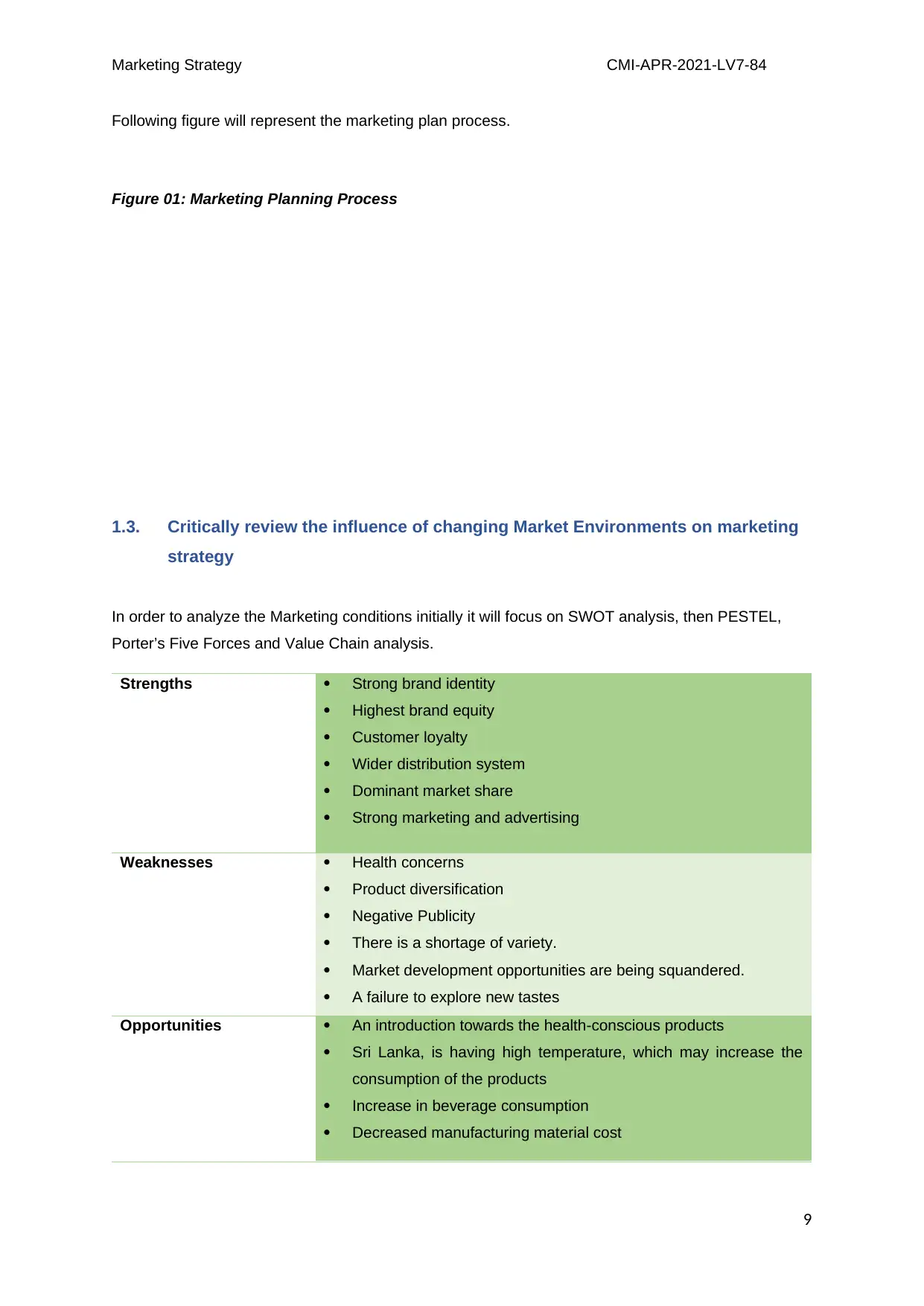
Marketing Strategy CMI-APR-2021-LV7-84
Following figure will represent the marketing plan process.
Figure 01: Marketing Planning Process
1.3. Critically review the influence of changing Market Environments on marketing
strategy
In order to analyze the Marketing conditions initially it will focus on SWOT analysis, then PESTEL,
Porter’s Five Forces and Value Chain analysis.
Strengths Strong brand identity
Highest brand equity
Customer loyalty
Wider distribution system
Dominant market share
Strong marketing and advertising
Weaknesses Health concerns
Product diversification
Negative Publicity
There is a shortage of variety.
Market development opportunities are being squandered.
A failure to explore new tastes
Opportunities An introduction towards the health-conscious products
Sri Lanka, is having high temperature, which may increase the
consumption of the products
Increase in beverage consumption
Decreased manufacturing material cost
9
Following figure will represent the marketing plan process.
Figure 01: Marketing Planning Process
1.3. Critically review the influence of changing Market Environments on marketing
strategy
In order to analyze the Marketing conditions initially it will focus on SWOT analysis, then PESTEL,
Porter’s Five Forces and Value Chain analysis.
Strengths Strong brand identity
Highest brand equity
Customer loyalty
Wider distribution system
Dominant market share
Strong marketing and advertising
Weaknesses Health concerns
Product diversification
Negative Publicity
There is a shortage of variety.
Market development opportunities are being squandered.
A failure to explore new tastes
Opportunities An introduction towards the health-conscious products
Sri Lanka, is having high temperature, which may increase the
consumption of the products
Increase in beverage consumption
Decreased manufacturing material cost
9
⊘ This is a preview!⊘
Do you want full access?
Subscribe today to unlock all pages.

Trusted by 1+ million students worldwide

Marketing Strategy CMI-APR-2021-LV7-84
Threats Criticisms regarding the water management system of the
organization
Single-use plastic bottles have a bad impact
High competition of the industry.
Table 02: SWOT Analysis of Coca Cola Company
Political Since Sri Lanka is still a developing country, there is no political
stability. Therefore, the country changes its taxes, regulations, special
regulations regarding beverages from time to time. Most frequently,
when the political parties change, these may change. However, when
these change from time to time, that may be a disadvantage to the
organisation.
Economical Sri Lanka has a really big issue with depreciating the domestic
currency. Further, covid-19 impacted the country's economy badly,
and that made to an economic recession. Those impact on increasing
the inflation rate as well. Therefore, the current situation in the
economy is not well, and that harms the organisation.
Social Sri Lanka has a high literacy rate. Further, recently the population in
the country is more concerned about health because there was a
gradual increment in the number of children with non-communicable
diseases. When people become more health conscious, that may
reduce the sales of the organisation.
Technological The company has good technological advancement, and the
company has a wide distribution system. Further, the company used
technology in operation and other organisational systems, which
impacts the organisation positively.
10
Threats Criticisms regarding the water management system of the
organization
Single-use plastic bottles have a bad impact
High competition of the industry.
Table 02: SWOT Analysis of Coca Cola Company
Political Since Sri Lanka is still a developing country, there is no political
stability. Therefore, the country changes its taxes, regulations, special
regulations regarding beverages from time to time. Most frequently,
when the political parties change, these may change. However, when
these change from time to time, that may be a disadvantage to the
organisation.
Economical Sri Lanka has a really big issue with depreciating the domestic
currency. Further, covid-19 impacted the country's economy badly,
and that made to an economic recession. Those impact on increasing
the inflation rate as well. Therefore, the current situation in the
economy is not well, and that harms the organisation.
Social Sri Lanka has a high literacy rate. Further, recently the population in
the country is more concerned about health because there was a
gradual increment in the number of children with non-communicable
diseases. When people become more health conscious, that may
reduce the sales of the organisation.
Technological The company has good technological advancement, and the
company has a wide distribution system. Further, the company used
technology in operation and other organisational systems, which
impacts the organisation positively.
10
Paraphrase This Document
Need a fresh take? Get an instant paraphrase of this document with our AI Paraphraser
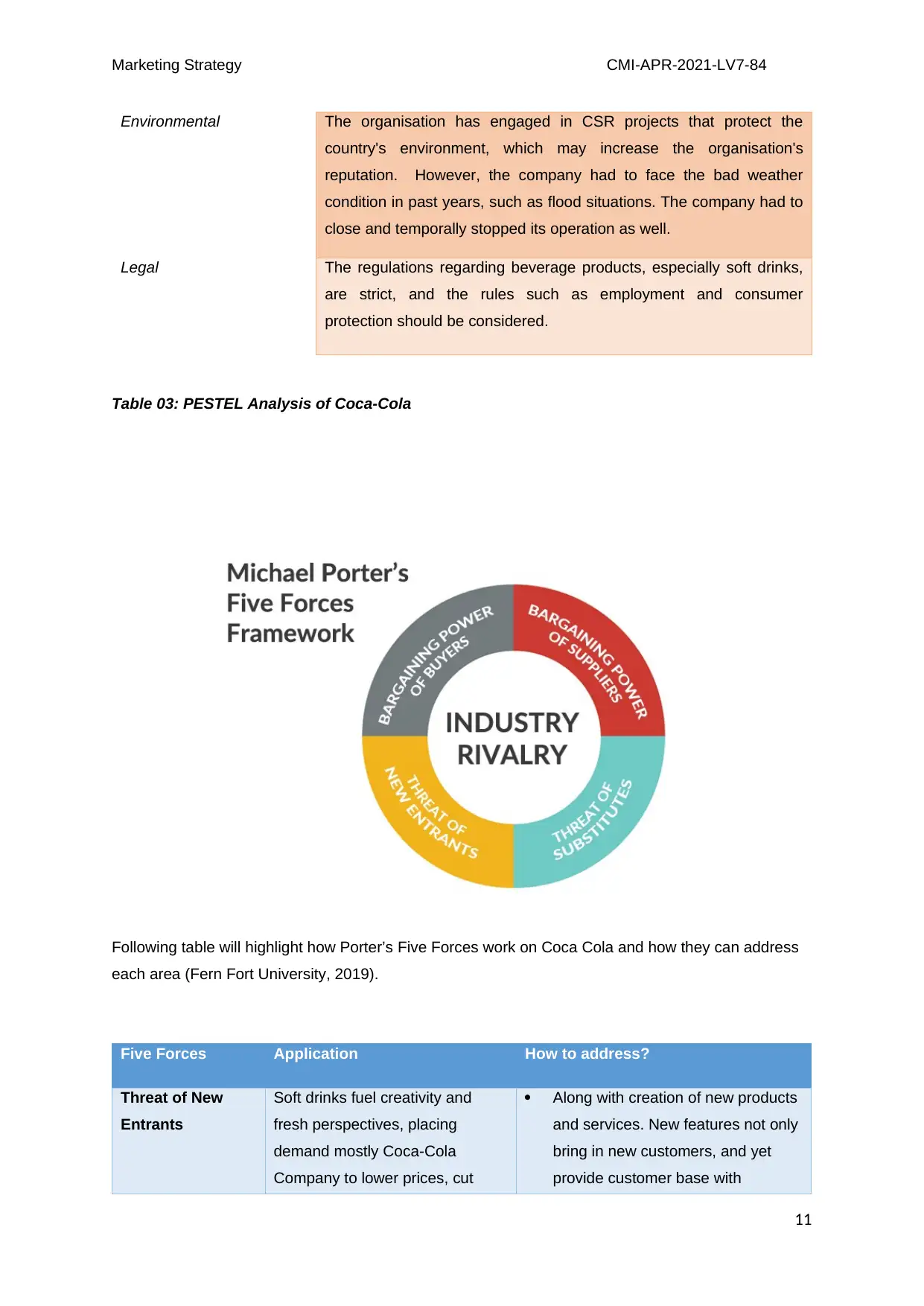
Marketing Strategy CMI-APR-2021-LV7-84
Environmental The organisation has engaged in CSR projects that protect the
country's environment, which may increase the organisation's
reputation. However, the company had to face the bad weather
condition in past years, such as flood situations. The company had to
close and temporally stopped its operation as well.
Legal The regulations regarding beverage products, especially soft drinks,
are strict, and the rules such as employment and consumer
protection should be considered.
Table 03: PESTEL Analysis of Coca-Cola
Following table will highlight how Porter’s Five Forces work on Coca Cola and how they can address
each area (Fern Fort University, 2019).
Five Forces Application How to address?
Threat of New
Entrants
Soft drinks fuel creativity and
fresh perspectives, placing
demand mostly Coca-Cola
Company to lower prices, cut
Along with creation of new products
and services. New features not only
bring in new customers, and yet
provide customer base with
11
Environmental The organisation has engaged in CSR projects that protect the
country's environment, which may increase the organisation's
reputation. However, the company had to face the bad weather
condition in past years, such as flood situations. The company had to
close and temporally stopped its operation as well.
Legal The regulations regarding beverage products, especially soft drinks,
are strict, and the rules such as employment and consumer
protection should be considered.
Table 03: PESTEL Analysis of Coca-Cola
Following table will highlight how Porter’s Five Forces work on Coca Cola and how they can address
each area (Fern Fort University, 2019).
Five Forces Application How to address?
Threat of New
Entrants
Soft drinks fuel creativity and
fresh perspectives, placing
demand mostly Coca-Cola
Company to lower prices, cut
Along with creation of new products
and services. New features not only
bring in new customers, and yet
provide customer base with
11

Marketing Strategy CMI-APR-2021-LV7-84
costs, and give competitive
advantages to customers. To
keep their strategic edge, the
Coca-Cola Company should deal
with all of these challenges and
put up relevant aspects.
motivation to purchase Coca-Cola
products.
The fixed cost per unit can be
lowered by establishing economies
of scale.
Investing in R&D as well as capacity
building. New arrivals are less
inclined to engage highly vibrant
industry when established
businesses, such as The Coca-Cola
Company, set the norm on a daily
basis. It significantly reduces the
window of opportunity for emerging
firms to achieve extraordinary
profits, deterring new entry into the
industry.
Bargaining Power
of Suppliers
Suppliers within a completely
dominant market might decrease
profits. Profitability is an
opportunity for the Coca-Cola
Company in the market. Market
power in the Consumer Goods
sector uses their negotiation
power to obtain higher prices from
firms in the Beverages-Soft
Drinks sector. Greater supplier
bargaining power significantly
reduces revenue in beverages-
soft drinks.
By establishing an efficient supply
chain with a diverse set of
providers.
By exploring new products that use
multiple resources, the company
may be able to switch to a different
raw material if the price of one
increase.
Bargaining Power
of Buyers
Buyers could be challenging.
They want to obtain the best
possible outcome while paying
the lowest amount. That damaged
The Coca-Cola Company's return
on the investment. Customers'
bargaining power as well as
ability to demand higher deals
and promotions grows as The
Coca-Cola Company's existing
customers declines and grows
Through amassing a sizable
clientele. This is advantageous in
two ways. This will reduce buyers'
bargaining power and facilitate the
firm the opportunity to streamline its
sales and operations.
12
costs, and give competitive
advantages to customers. To
keep their strategic edge, the
Coca-Cola Company should deal
with all of these challenges and
put up relevant aspects.
motivation to purchase Coca-Cola
products.
The fixed cost per unit can be
lowered by establishing economies
of scale.
Investing in R&D as well as capacity
building. New arrivals are less
inclined to engage highly vibrant
industry when established
businesses, such as The Coca-Cola
Company, set the norm on a daily
basis. It significantly reduces the
window of opportunity for emerging
firms to achieve extraordinary
profits, deterring new entry into the
industry.
Bargaining Power
of Suppliers
Suppliers within a completely
dominant market might decrease
profits. Profitability is an
opportunity for the Coca-Cola
Company in the market. Market
power in the Consumer Goods
sector uses their negotiation
power to obtain higher prices from
firms in the Beverages-Soft
Drinks sector. Greater supplier
bargaining power significantly
reduces revenue in beverages-
soft drinks.
By establishing an efficient supply
chain with a diverse set of
providers.
By exploring new products that use
multiple resources, the company
may be able to switch to a different
raw material if the price of one
increase.
Bargaining Power
of Buyers
Buyers could be challenging.
They want to obtain the best
possible outcome while paying
the lowest amount. That damaged
The Coca-Cola Company's return
on the investment. Customers'
bargaining power as well as
ability to demand higher deals
and promotions grows as The
Coca-Cola Company's existing
customers declines and grows
Through amassing a sizable
clientele. This is advantageous in
two ways. This will reduce buyers'
bargaining power and facilitate the
firm the opportunity to streamline its
sales and operations.
12
⊘ This is a preview!⊘
Do you want full access?
Subscribe today to unlock all pages.

Trusted by 1+ million students worldwide
1 out of 23
Related Documents
Your All-in-One AI-Powered Toolkit for Academic Success.
+13062052269
info@desklib.com
Available 24*7 on WhatsApp / Email
![[object Object]](/_next/static/media/star-bottom.7253800d.svg)
Unlock your academic potential
Copyright © 2020–2025 A2Z Services. All Rights Reserved. Developed and managed by ZUCOL.





